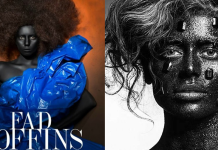Not too long ago it was okay for a person to wear a Native American inspired hat to a Halloween party or wear an Indian bhindhi to a concert. If you’re Caucasian and you’re wearing peshawari chappals and calling them ‘Robert’ shoes and selling them for a thousand dollars, it may cause offense to certain people. Yes, I am referring to Paul Smith, and what he did is called cultural appropriation.
The idea of dominating minority based cultures is called cultural appropriation, it is considered offensive and controversially negotiable. The concept of mis-appropriation and appropriation is often misunderstood, and both of them are seen as wrongfully oppressing the minority culture or stripping it of its group identity and intellectual property rights.
In a world with fast-growing multiculturalism, the line between appreciation and appropriation of cultures steadily blurs. In 2003, Gwen Stefani donned a bindi in No Doubt’s “Just a Girl” music video, and stars have been following suit ever since. Both Selena Gomez and M.I.A have come under fire in recent times for cultural tourism in their music videos, the latter being forced to scrap hers altogether. In the mainstream, cultural appropriation is perhaps most obvious by the sheer number of bindi-adorned girls at music festivals like Coachella. Asian, black, Native American and other marginalized groups are persistently having their cultures appropriated by those who feel entitled to it, thereby perpetuating a harmful power dynamic.
In a different allegorical might, pointing out cultural appropriation can be seen as racism. It’s like telling someone to “stick to their kind”, especially when this is being defended by the self-proclaimed, so-called activist, feminist and anti-racists. Going by this, the idea of feminism and all other isms might be discarded. This also means that it’s okay to sexually segregate people. Take Pakistan for example, where people aren’t accustomed to accepting women as their competitors. They still believe in sexual segregations in offices or classes, where a man can sit confidently and a woman has to act like a fragile, delicate little flower. Pakistani culture is all about the idea of women living in a shell. Wouldn’t it be culturally inappropriate for a girl to sit with guys or wear jeans at all? Isn’t it culturally inappropriate for guys to wear jeans or shirts or suits or ties? Judging by that logic, Pakistanis should stick to their roots by wearing a sherwani to all formal events and donning the shalwar kameez on a daily basis, but why don’t we?
Telling someone that they shouldn’t wear dreadlocks since they are not black, and that dreadlocks are culturally indigenous to black people, hence they alone have the legal, moral right to have them sounds rude and racist.
Labelling everything as cultural appropriation is a perfect recipe for a less enlightened outlook. If we start surrounding ourselves with people from the same culture, who talk, think, dress and look the same way then we are surely limiting ourselves. This also means that we need to stop traveling. What’s the point of traveling to Italy and not being able to eat, taste and experience their culture? This would put an end to so many aspects of creative and artistic avenues. I think that this would be equivalent to borderline insanity to even consider that we should not accept or embrace bits and parts of cultures and values that we like. Considering the multicultural-globalized world we live in, it is imperative that we have multicultural exposure, since it helps to broaden our mindset and our basic approach to life.
Does this mean that one can no longer order sushi in a Japanese restaurant if they’re not Japanese? Won’t this mark an end to cultural diversity and end up segregating us once again?
Fetishizing other cultures or making fun of them is legitimately wrong. If people are celebrating cultures they love or wearing clothing items from other cultures, it may be okay to do that. It’s okay to embrace elements from other cultures as long as you are not mocking any aspect of it. I think it’s okay to dress up as your favorite character from your favorite book or a movie. However, all of the above is obviously very different from blatantly dressing up as someone of another culture to stereotype them. This is legitimate cultural appropriation and it is racist.
People need to differentiate between genuine cultural appropriation, especially if it’s used for profit, and cultural misappropriation, which is usually an accident. If a person is attending a cultural event that isn’t indigenously relevant to them for the sake of celebrating it or embracing it, you cannot dub that as cultural appropriation. There is a dire need to start categorizing legitimate instances of cultural appropriation, rather than lumping everything together.
Labelling everything as cultural appropriation and wrongfully accusing people of being culturally insensitive, leads to division and hate crimes. Accepting that other people can enjoy aspects of other cultures doesn’t suggest that we are going to forget its origin or devalue its originality. Things with a historical background to them should be respected.
If a person is adopting certain aspects of your culture for the sake of appreciation, while correctly informing themselves of its origins, with no intentions to mock or exploit it in any way, it cannot be considered cultural appropriation.
Moschino using embroidery techniques such as the indigenous mirror work as an inspiration for their spring summer collection and not crediting the craftsmanship is what you can label as cultural appropriation. The ideas of making money out of someone else’s culture and using it to sell products or gain hype without giving them due credit is legitimately wrong.
Recently, and much more controversially, Dolce & Gabbana SS13 was covered in black moor imagery – offensive, Mammy-like stereotypical depictions of African women that appeared on dresses and as earrings – in a show that did not feature a single black model in nearly a 100 looks. This clearly disrespects a certain region and a class of people and it is wrong.
The answer to whether designers or artists should be allowed to take inspiration from other cultures is that they can and they should – with respect, appreciation, and an understanding of its history. Vaguely pinning down a collection’s inspiration as “Africa” with words such as “tribal”, “primitive”, “wild” or “ethnic”, bongo drums and animal prints, completely reduces an entire continent (one that’s bigger than America, China, India and half of Europe put together, is home to over a billion people and has over 2000 languages spoken) into a few archaic and racist stereotypes.
Designer Kunal Anil Tanna said, “When one is borrowing an element from a different culture, it always makes sense to be well-informed about its significance. We should represent it appropriately,” he says. Designer Nida Mahmood said that if one is borrowing from another culture, it’s important to respect the origin. “I see nothing wrong in picking up elements from various cultures. Due credit must be given to the culture you’re borrowing from,” she says
Alexander McQueen, Dior, Yves Saint Laurent and Galliano have spurred controversies in the past and gotten away with it. Inspirations and work should not offend people, instead they should aim to educate the general public regarding cultural origins, as opposed to calling them African or Indian.
The problem with appropriation is that it takes without giving. It turns culturally significant items into decorations- stripped of their meaning or heritage, and then sells them as luxury goods for eye-watering prices. It’s hard to imagine that, had an African designer put on the same show as Valentino and used African models, the collection would have been lauded as new, novel, or inspired. Furthermore, the use of catchall words like “ethnic” to mean “not white” or “not European” show just how overwhelmingly white-dominated the fashion industry is – it’s easier to fall back on a generic term than be specific and thorough in your research or understanding of a certain print or style of beading. While there are a fair few Japanese designers on the official Paris Fashion Week schedule, only one of 91 is black – Olivier Rousteing. There was a lack of diversity in the models chosen– even for collections inspired by communities of color – which demonstrates that the mainstream fashion world’s problem with race and casting is pervasive and ongoing.
The work of a Pakistani- Canadian artist takes “desi scenarios” and interrelating it with “not so indigenous” pop art. She was accused of committing cultural appropriation and labelled racist. The humor behind her work was lost on several people, and all she was doing was coming up with something creative- art is supposed to be like that. The scenario of where she was brought up resonates in her work, and yet people chose to mislabel it.
Cultural appropriation is, and will continue to be a controversy for days to come. Labelling something as cultural appropriation depends on scenarios and situations. It’s hard to blur the lines between appropriation and appreciation; the concept of celebrating, embracing and appreciating other cultures and giving them the due respect is what matters in the end.


